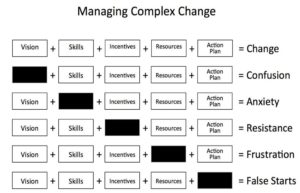Creating a company culture is about building up a team environment that fosters joy, productivity, and results all at the same time. When you do this right, your people wake up excited to come to work and be in each others’ presence; they also do great work, period.
As a CEO, it’s your responsibility to design this experience, and that’s a big task! I’ll share some tips below, but I also suggest that you read everything you can get your hands on about company culture and make this a dedicated, ongoing effort and investment at your organization.
Create a shared mission and values that inspire.
Because mission, vision, and values can often be viewed as time-consuming and/or misaligned with reality at many institutions, it can be easy to overlook them. But the truth is that if you want people to go all out and get the job done, then they need to deeply believe in something bigger than themselves, which means they need to feel passionate about the work and the mission. So, this is actually a critical component of building both a team and the culture of your dreams!
And this doesn’t happen overnight or without intention. Here are 3 tips for the journey: Have deep, lengthy conversations about the values that everyone in the company can get behind.
Have detailed brainstorming sessions about how those values are operationalized on a day-to-day basis. For example, ask the question “what does [accountability] look like in our office every day?” and encourage people to be specific with their answers. Document your manifesto, values, or agreements and have those made available to everyone. Posters and wall decorations are a good way of doing this!
Participate in fun, thoughtful rituals that reinforce your values.
Open meetings with rituals tied to those values you’ve identified. For example, if your core value is No Unhappy Customers, then open each meeting with a story about customer service and the difference it’s made to someone. Or, if your core value is teamwork, then you could have quarterly team competitions or use scorecards.
Instill a sense of pride in what you all are a part of.
Employees who are proud of what they do are less likely to quit, and in fact, are often great ambassadors for the company. Make sure people are proud of what you are all doing together to impact the world. Celebrate your success stories, accolades, and impact reports. Make sure every team member understands and hears frequently how their job is critical to the company’s overall success. Give ownership of wins to the entire team and in turn they will more likely take ownership of the hard work that it takes to get those wins.
Have your team’s back.
When your employees struggle, make sure that you provide necessary and reasonable support. Extend grace while also holding them accountable. It’s a delicate dance, but if you tend to be a boss with high expectations, make sure to balance those out with resources, training, and encouragement. Side note: Choosing the right team is critical or none of these tips matter!
Model everything you want to see.
If you want accountable staff, then be openly accountable for your own actions and behaviors. If you want a team that is data-driven, then drive your discussions with data and invest in data systems. If you want a team that treats your customers like family, then treat your customers like family. The best on-the-job training is in what employees see, not what they hear or read in SOPs.
Create a team spirit, where people love the people they work with.
The team that works together stays together. Be mindful of how the workplace stimulates feelings of competition or any culture-related elements that pit employees against each other. Instead, work to create a culture where employees love, and find it rewarding, to work with each other and look out for each other. I once conducted employee interviews – individually – in an organization where every person when asked said the number one thing they loved about their job was the people. One by one, each person entered the interview and shared the company’s core beliefs and priorities almost identically. That company had had almost no turnover of their core staff in 10 years.
Create space that is safe and courageous at the same time.
This is another delicate dance, but it’s critically important to create a space where people feel safe to fail but are also willing to be held accountable. Safe spaces are about providing resources and genuine opportunities to grow, learn, innovate, improve and ask for help. Meanwhile, courageous spaces are about honest feedback, consistency in accountability, and a willingness to own growth areas, limitations, or mistakes.
Create ideal working conditions.
As the CEO, you have the tough but rewarding job of creating ideal working conditions for your employees. What an “ideal” workplace might look like differs depending on your industry and the size of your team, but there are also some things that carry over no matter where you operate.
After surveying hundreds of CEOs at major companies worldwide, EY offers three key recommendations for effective business leaders, the first of which is: center people. Other solid recommendations include fostering inclusivity and motivation, and also showing employees that their ideas, input, and work are valued. If you focus working conditions on making employees seen, heard, and valued, you can improve performance up to 75%!
I love the graphic below on managing change. I think it’s a great reference for what to focus on in order to design the culture of your dreams and prevent confusion, anxiety, and other negative energies in your business.

If nothing else, Sis, your big takeaway here should be this: culture is the key to creating a team that is productive, happy, proud, and all-in for your business. Study and invest in designing the company culture of your dreams, and you’ll find the business and lifestyle of your dreams will manifest as well!
Share below and let us know if you have best practices or good reads on this topic!

